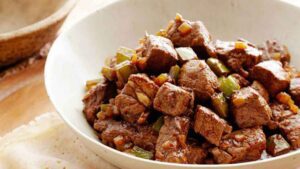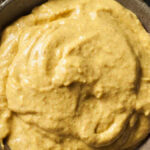Introduction to Ethiopian Food
Ethiopian food is one of the most unique and flavorful cousins in the world, with a complex and diverse culinary tradition that has been shaped by the country’s varied geography, rich history, and vibrant culture.
At the heart of Ethiopian cuisine is Injera, a spongy, sourdough flatbread that is used as both a utensil and a plate. Alongside injera, Ethiopian dishes are typically characterized by their bold and complex flavors, which are achieved through the use of unique spice blends, including the fiery Berbere and the fragrant Mitmita.
In this blog post, we’ll explore the history of Ethiopian cuisine, the staple ingredients used in Ethiopian cooking, traditional Ethiopian dishes, regional variations in Ethiopian cuisine, Ethiopian coffee culture, Ethiopian restaurants and food in the diaspora, and answer some frequently asked questions about Ethiopian food.
Ethiopian Food and Culture

Ethiopian food is deeply intertwined with Ethiopian culture, and plays a significant role in social and religious gatherings. In Ethiopia, food is typically eaten with the hands, with diners using torn pieces of injera to scoop up stew and other dishes. This communal style of dining is known as Gursha, and is a way for Ethiopians to bond and connect over food.
Ethiopian food is also heavily influenced by religious traditions, particularly the Ethiopian Orthodox Church. Many Ethiopian dishes are vegan, as the Orthodox Church observes over 200 fasting days throughout the year, during which meat and dairy products are prohibited.
How to Enjoy Ethiopian Food
If you are new to Ethiopian food, it can be helpful to know how to properly enjoy the food. Here are a few tips to get the most out of your Ethiopian dining experience:
Eating With Hands
One of the most unique aspects of Ethiopian food is the tradition of eating with your hands. It’s not just about the convenience, but it is also considered a way of showing respect and creating a bond with others. Eating with your hands helps to enhance the experience and the sense of community.
Communal Eating
Traditional Ethiopian meals are often served on large, round platters called “Mesob” that are lined with injera (a sourdough flatbread made from teff flour). The different dishes are arranged around the injera, and everyone eats from the same plate. This communal style of dining is another way of promoting togetherness and sharing.
Right-Hand Rule
When eating with your hands, it is important to use your right hand only. The left hand is considered unclean since it is typically used for personal hygiene purposes. So, always make sure to use your right hand while eating and avoid using your left hand as much as possible.
Hand Washing
Before and after the meal, it is essential to wash your hands thoroughly. In some restaurants or homes, a server will bring a basin and pitcher of water with soap to the table for everyone to wash their hands.
Gursha
Gursha is a special gesture of respect and friendship. It is when someone takes a small piece of food, rolls it up with injera, and feeds it directly to your mouth. This is a common practice between close friends or family members, and it’s a way of showing affection and appreciation.
Elder Respect
In Ethiopian culture, respect for elders is paramount. Therefore, it is customary to allow any elders present to begin eating before you do. If you happen to be the oldest person present, Ethiopians will patiently wait until you start to eat before they begin. This is a way of showing respect and honor to those who are older and wiser.
Coffee Is A Must
Coffee is an important part of Ethiopian culture, and the coffee ceremony is a social ritual that is often shared with guests. Be sure to try the coffee, and enjoy the traditional snacks that are served alongside it, such as Fendisha (popcorn)
Don’t Be Afraid To Ask Questions
If you are unsure about a particular dish or ingredient, don’t be afraid to ask your server or host for more information. Ethiopian cuisine is rich with history and culture, and asking questions can be a great way to learn more..
The Essential Components & Staple Ingredients of Ethiopian Food
Ethiopian cuisine is known for its unique flavors and textures, which are derived from a variety of staple ingredients. These ingredients form the backbone of many traditional Ethiopian dishes, providing the base for stews (Wot dishes), soups, and other flavorful dishes. In this blog post, we’ll take a closer look at the staple ingredients in Ethiopian cuisine and explore their culinary significance.
Teff

Teff is an ancient, small, gluten-free grain that is native to Ethiopia and is the main ingredient in Injera, a spongy sourdough flatbread that is a staple of Ethiopian cuisine. Teff is high in protein, fiber, and a range of essential minerals, making it a highly nutritious and healthy addition to any diet.
Injera
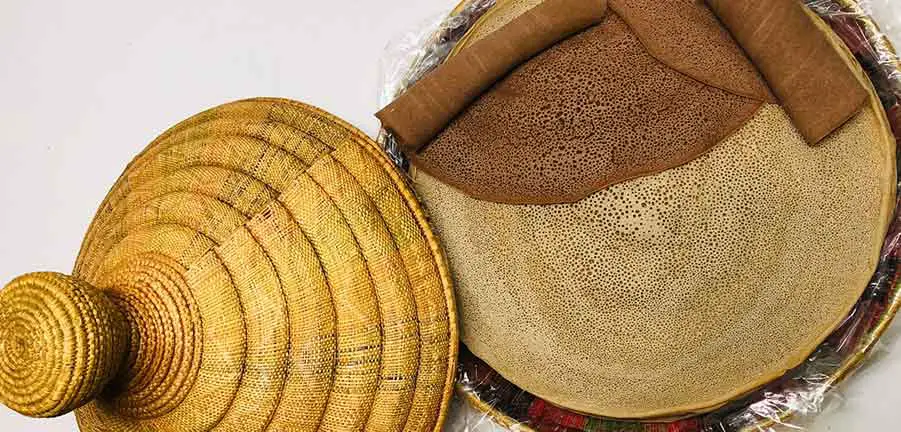
Injera is the backbone of Ethiopian cuisine, serving as both a plate and a utensil. Made from the tiny Teff grain, which is ground into a fine flour, Injera is a sourdough flatbread that is fermented for several days before being cooked on a large, round griddle. The result is a spongy, slightly sour bread that has a unique texture and flavor. Injera is typically served alongside a variety of stews and sauces, where it’s used to scoop up and eat by hand. This tradition of scooping up and eating by hand is known as Gursha in Amharic.
Wot
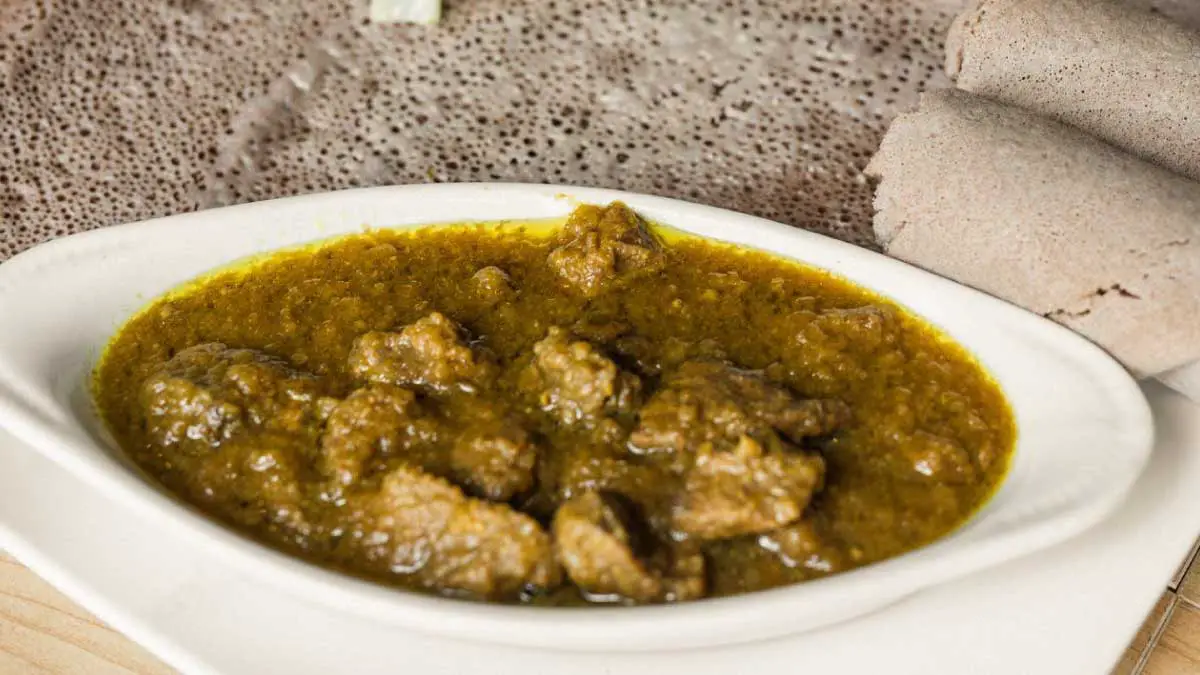
Wot, the Amharic word for stew, is a central component of Ethiopian food, and comes in a variety of forms. Typically made from meat, vegetables, or legumes, Wotis flavored with a variety of spices, including Berbere and Mitmita. Some of the most popular Wot dishes include Doro Wot, a spicy chicken stew, and Shiro Wot, a vegetarian stew made from ground chickpeas.
Lentils, Chickpeas, and Legumes
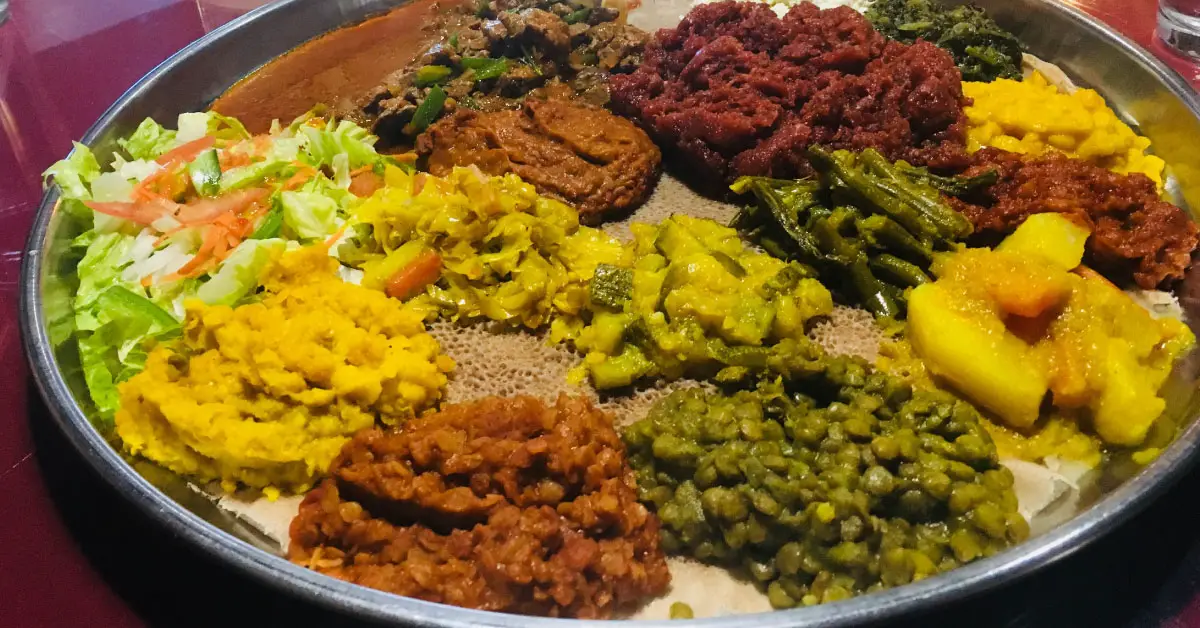
Ethiopian cuisine is also known for its extensive use of lentils, chickpeas and other legumes, which are used to make a variety of stews, soups and salads. They are a good source of protein and are often used as a meat substitute in vegan and vegetarian dishes. One of the most popular lentil dishes is Misir Wot, a spicy stew made from red lentils and flavored with Berbere and other spices.
Berbere

Berbere is a spicy, aromatic spice blend that is an essential ingredient in many Ethiopian dishes. It is made from a combination of dried chili peppers, garlic, ginger, cumin, and other spices, and is often used to flavor stews and soups. Berbere can be adjusted to suit individual tastes, with some versions being spicier or milder than others.
Niter Kibbeh

Niter Kibbeh is a type of clarified butter that is infused with spices such as cardamom, cinnamon, and turmeric. It is a key ingredient in many Ethiopian dishes, providing a rich, complex flavor that complements the other ingredients in the dish. Niter Kibbeh can be made at home or purchased at specialty stores.
Traditional Ethiopian Dishes
Ethiopian cuisine is a rich and diverse culinary tradition that is known for its unique spices and its flavorful and hearty dishes. Ethiopian food is characterized by its use of stews and sauces, which are typically served on a large communal platter with Injera, a sourdough flatbread. In this blog post, we’ll explore some of the most traditional Ethiopian dishes and their significance in Ethiopian cuisine.
Doro Wot

Doro Wot is perhaps the most famous Ethiopian dish, and it is often considered the country’s national dish. It is a rich and spicy chicken stew that is made with a flavorful spice blend called Berbere. Berbere is made from a mix of chili peppers, garlic, ginger, and other spices, and it gives the dish its signature heat and depth of flavor. Doro Wot is typically served on a large communal platter with Injera.
Tibs
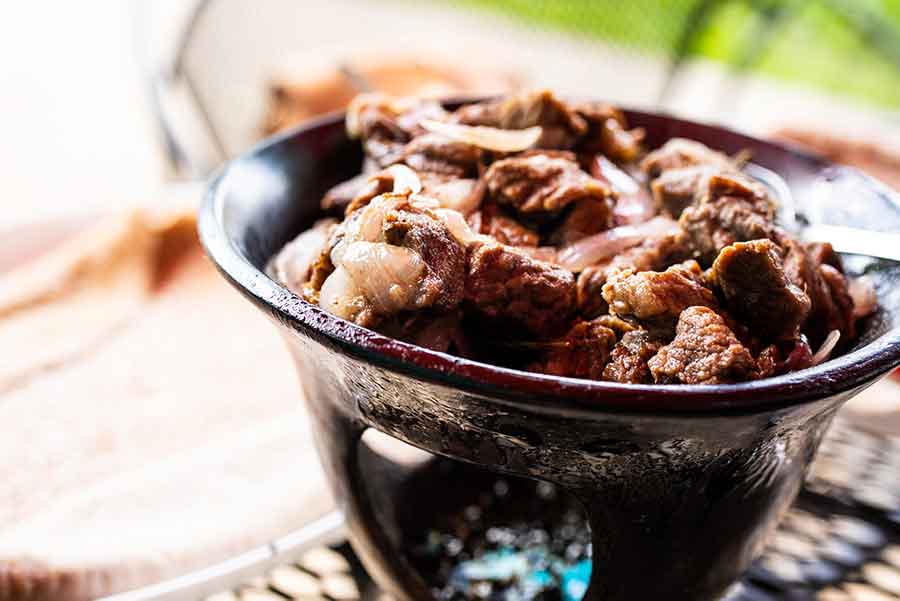
Tibs is a popular Ethiopian dish made form grilled or sautéed beef, lamb, or goat meat, seasoned with spices such as ginger, garlic, and rosemary. The meat is often cooked with onions, peppers, and tomatoes, and it is served on a bed of Injera. Tibs is a popular dish in Ethiopian restaurants and is often served as an appetizer or as part of a larger meal.
Kitfo
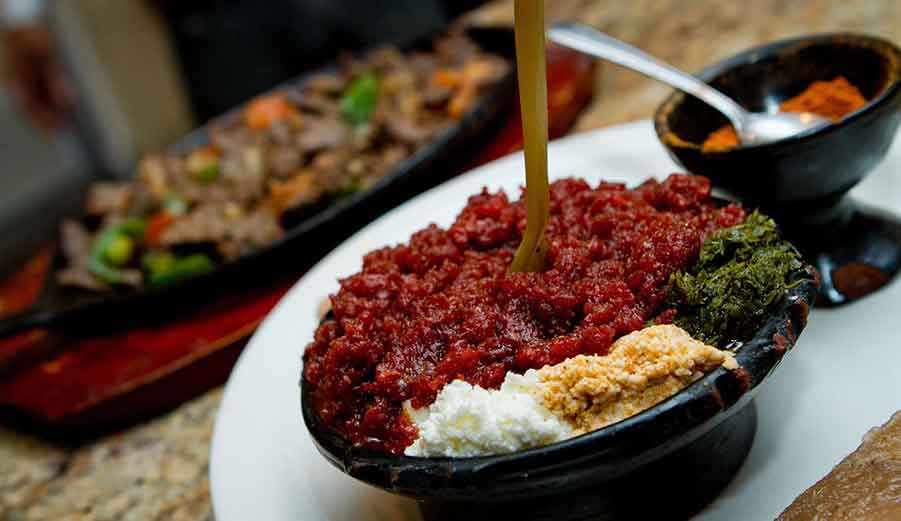
Kitfo is a dish of finely minced beef that is mixed with spices and served with Injera. The beef is seasoned with a blend of spices that typically includes chili powder, cardamom, and ginger. Kitfo is often served with a side of Ayib, a type of cottage cheese that is made from yogurt. Kitfo can be served raw, rare, or well cooked.
Shiro Wot
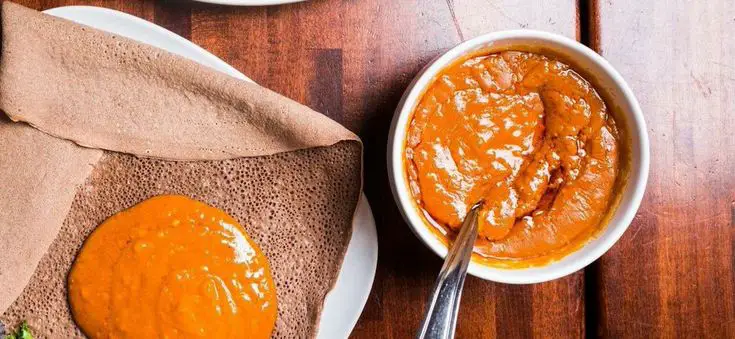
Shiro Wot is a vegetarian stew that is made from ground chickpeas, onions, garlic, and Berbere. It is a popular dish in Ethiopia and is often served with Injera. Shiro Wot is typically seasoned with a blend of spices that includes cumin, turmeric, and paprika.
Fasolia

Fasolia is a dish of stewed green beans that is often served with Injera. The beans are cooked with onions, tomatoes, and spices, and they are typically seasoned with garlic, ginger, and turmeric. Fasolia is a popular vegetarian dish in Ethiopia, and it is often served as part of a larger meal.
Ethiopian Restaurants and Food in the Diaspora

Ethiopian restaurants can be found in many major cities around the world, and Ethiopian cuisine has gained popularity in recent years. In addition to traditional dishes such as injera and Wot, Ethiopian restaurants often offer vegetarian and vegan options. Ethiopian cuisine has also influenced fusion cuisine, with chefs incorporating Ethiopian flavors and spices into their dishes.
Ethiopian cuisine has gained immense popularity in recent years, thanks in part to the large diaspora community around the world. Ethiopian restaurants have popped up in cities all over the globe, serving up delicious and authentic dishes that showcase the flavors and traditions of Ethiopia.
The Rise of Ethiopian Restaurants in the Diaspora
The Ethiopian diaspora has played a major role in spreading awareness of Ethiopian cuisine around the world. Many Ethiopians have moved to other countries in search of better economic opportunities, bringing with them their cultural heritage and culinary traditions.
In the 1970s and 1980s, Ethiopian restaurants began to emerge in cities like Washington D.C., Los Angeles, and New York, catering primarily to the growing Ethiopian community in these areas. However, as more people became interested in trying new and exotic cuisines, Ethiopian restaurants began to attract a wider audience.
Today, Ethiopian restaurants can be found in cities around the world, from London to Tokyo to Melbourne. Many of these restaurants are owned and operated by Ethiopians or members of the Ethiopian diaspora, who are passionate about sharing their food and culture with others.
What to Expect at an Ethiopian Restaurant
If you’ve never been to an Ethiopian restaurant before, you might be surprised by the dining experience. Ethiopian cuisine is typically served family-style, with dishes placed on a large platter or injera-lined basket in the center of the table. Diners use pieces of injera to scoop up bites of the various stews and curries, creating a communal and convivial atmosphere.
Many Ethiopian restaurants also offer a range of vegetarian and vegan options, as Ethiopian cuisine features many meat-free dishes made with lentils, chickpeas, and vegetables. Ethiopian cuisine is also known for its spicy flavors, particularly dishes made with berbere spice, so be sure to ask your server about the heat level of the dishes you’re ordering.
Ethiopian Food Festivals and Events
In addition to restaurants, the Ethiopian diaspora has also created a vibrant food culture through festivals and events. Across the world, you can find Ethiopian food festivals celebrating the cuisine and culture of Ethiopia.
One of the most popular events is the Ethiopian Food Festival in Washington D.C., which attracts thousands of visitors each year. The festival features food vendors selling traditional Ethiopian dishes, along with music and dance performances and cultural exhibits.
Other events include the Ethiopian Cultural Festival in Melbourne, Australia, which showcases the food, music, and art of Ethiopia, and the Ethiopian Festival in Toronto, Canada, which features traditional Ethiopian food and drinks, along with a fashion show and cultural performances.
A Brief History of Ethiopian Food
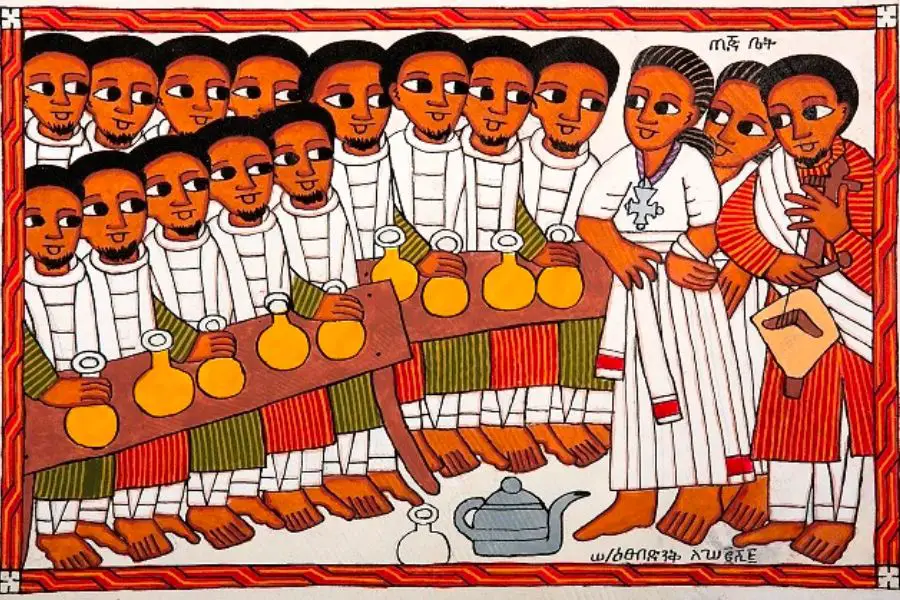
Ethiopian cuisine is a unique and diverse culinary tradition that is deeply rooted in the country’s history and culture. With its rich flavors and textures, Ethiopian cuisine has captured the hearts and taste buds of food lovers around the world. But where did this ancient cuisine come from, and how has it evolved over time? In this section, we’ll explore the history of Ethiopian cuisine and its cultural significance.
The Roots of Ethiopian Food
Ethiopian cuisine has a long and storied history that dates back thousands of years. The country’s fertile soil, abundant water supply, and favorable climate have allowed for the cultivation of a wide variety of crops, including teff, wheat, barley, lentils, and chickpeas. These crops form the foundation of many traditional Ethiopian dishes, including injera, a sourdough flatbread made from teff flour that is used as a utensil to scoop up stews and other dishes.
In addition to its agricultural heritage, Ethiopian cuisine is also deeply influenced by the country’s diverse ethnic and religious communities. Over the centuries, Ethiopia has been home to many different peoples, including the Oromo, Amhara, Tigray, and Gurage, each of which has contributed its own unique culinary traditions and flavors to the country’s cuisine.
The Evolution of Ethiopian Food
Over time, Ethiopian cuisine has evolved and adapted to changing circumstances and influences. For example, the arrival of Islam in Ethiopia in the 7th century brought with it a prohibition on the consumption of pork, which led to the development of many vegetarian and vegan dishes. Similarly, the Ethiopian Orthodox Church, which has been a powerful force in Ethiopian society for over a millennium, observes over 200 fasting days throughout the year, during which meat and dairy products are prohibited. This has led to the development of many vegan dishes, as well as the use of traditional ingredients such as niger seed and false banana (enset) as meat substitutes.
In more recent times, Ethiopia’s exposure to foreign cultures and influences has also played a role in the evolution of its cuisine. For example, the Italian occupation of Ethiopia in the early 20th century introduced new ingredients and cooking techniques, such as pasta dishes and tomato-based sauces, that have since become part of the country’s culinary repertoire.
The Cultural Significance of Ethiopian Food
Food plays an important role in Ethiopian culture, serving as a way for people to connect with their community and celebrate important events and milestones. In many parts of Ethiopia, food is shared communally, with diners using their hands to scoop up injera and other dishes. This communal style of dining, known as gursha, is a way for Ethiopians to bond and connect over food.
Ethiopian cuisine is also deeply intertwined with religious traditions, particularly the Ethiopian Orthodox Church. Many Ethiopian dishes are vegan or vegetarian, in keeping with the church’s fasting traditions, and are often served during religious holidays and celebrations
Regional Variations in Ethiopian Food
Ethiopian cuisine is not homogenous, and varies significantly from region to region. Here are a few examples of regional differences in Ethiopian cuisine:
Amhara
The Amhara region is known for its hearty meat dishes, including Tibs and Doro Wot. In addition to meat-based dishes, Amhara cuisine also features a variety of vegetable, lentil, and other legume stews, including Shiro Wot and Fasolia.
Tigray
Tigray is a region in northern Ethiopia that is known for its spicy and flavorful dishes. Tigrayan cuisine is characterized by the use of chili peppers and other fiery spices, as well as the use of Tsebhi, a type of clarified butter that is similar to Indian ghee. Tigray is known for its breads, including the popular injera-like dish called Himbasha (Ambasha). Tigray is also known for its Shiro, which is a stew made from ground chickpeas or lentils.
Oromia
Oromia is a region in central Ethiopia that is known for its agricultural production, including crops like coffee, teff, and maize. Oromia is known for its spiced butter, called Kibe, which is used in many traditional Oromo dishes. The region is also known for its sautéed or grilled meat dishes, such as Dulet, a spicy dish made from ground meat and tripe. Oromia cuisine also features a variety of vegetarian and meat-based dishes, with a particular emphasis on lentils and legumes.
Southern Nations, Nationalities, and Peoples’ Region (SNNPR)
The Southern Nations, Nationalities, and People’s Region (SNNPR) is one of the most diverse regions in Ethiopia, with over 50 different ethnic groups and languages. As a result, Southern Ethiopian cuisine is incredibly varied, with dishes ranging from the meat-heavy cuisine of the Konso people to the spicy vegetarian dishes of the Gurage people. The SNNPR is also known for its honey wine, called Tej, which is often served during Ethiopian celebrations and special occasions. The region is also known for its coffee, which is grown in the highlands and is a major export for Ethiopia.
FAQs About Ethiopian Food
Ethiopian food is a delicious and unique cuisine that is becoming increasingly popular around the world. With its exotic flavors and spices, it’s no wonder that people are curious about Ethiopian food. In this blog post, we’ll answer some of the most frequently asked questions about Ethiopian food.
Is Ethiopian food spicy?
Yes, many Ethiopian dishes are quite spicy, particularly those seasoned with berbere spice, which can be quite hot. However, not all Ethiopian dishes are spicy, and many restaurants offer milder options for those who prefer less heat.
Can Ethiopian food be vegetarian or vegan?
Yes, Ethiopian cuisine includes a wide variety of vegetarian and vegan dishes, including lentil stews and vegetable wot dishes.
Is Ethiopian food vegan and vegetarian friendly?
Ethiopian cuisine has a rich tradition of vegetarian and vegan dishes. Many Ethiopian Orthodox Christians follow a fasting diet that includes periods of abstaining from meat, so vegetarian dishes are an important part of Ethiopian cuisine. Some of the most popular vegetarian dishes in Ethiopian cuisine include Shiro Wot, Misir Kik, Fasolia, and Gomen. Injera, the sourdough flatbread, is also vegan.
However, it is important to note that some dishes may be prepared with animal products or animal-based seasonings, so it’s always best to check with the restaurant or chef.
What is the difference between injera and traditional bread?
Injera is a sourdough flatbread that is fermented before cooking, giving it a distinctive tangy flavor. It is also made from the Teff grain, while most of the other traditional breads in Ethiopia are typically made from wheat or barley flour.
Is Ethiopian food gluten-free?
Injera, the sourdough flatbread that is a staple in Ethiopian cuisine, is usually gluten-free because it is typically made from teff flour. However, if the Injera is made form wheat or barley flour, it won’t be gluten-free. Therefore, if you have a gluten allergy or intolerance, it’s important to ask about the ingredients in the dishes you’re considering.
Is Ethiopian food healthy?
Ethiopian food is generally considered to be healthy and nutritious. Many Ethiopian dishes are made with whole grains, legumes, and vegetables, and they are often low in fat and high in fiber. Injera, the sourdough flatbread that is a staple in Ethiopian cuisine, is made from teff flour, a highly nutritious grain that is rich in protein, fiber, and minerals.
Is Ethiopian food similar to other African cuisines?
Ethiopian cuisine is unique and distinct from other African cuisines, although it does share some similarities with the food of neighboring countries like Eritrea and Somalia. Ethiopian cuisine is characterized by its use of spices, its sourdough flatbread (injera), and its rich tradition of vegetarian and vegan dishes.
What is the significance of coffee in Ethiopian culture?
Coffee is an important part of Ethiopian culture and tradition, and Ethiopia is widely regarded as the birthplace of coffee. Coffee ceremonies are a common practice in Ethiopian households and communities, and they involve roasting, grinding, and brewing fresh coffee beans in a traditional pot called a jebena. Coffee is often served with snacks like popcorn or roasted barley.
What is the significance of injera in Ethiopian cuisine?
Injera is a staple in Ethiopian cuisine and is used as both a utensil and a food item. It is a sourdough flatbread made from teff flour, and it has a slightly tangy flavor that pairs well with the rich, spicy stews and sauces that are common in Ethiopian cuisine. Injera is also high in protein, fiber, and minerals, making it a nutritious and filling addition to any meal.
What are some popular Ethiopian beverages?
Ethiopian coffee is world-renowned for its rich, bold flavor, and it is an important part of Ethiopian culture and tradition. Other popular Ethiopian beverages include tej, a honey wine that is often served at special occasions and celebrations, and t’ella, a traditional beer made from barley or maize.
What are some popular Ethiopian desserts?
Ethiopian cuisine is not particularly known for its desserts, but there are a few sweet treats that are worth trying. One popular dessert is called baklava, a sweet pastry made with layers of phyllo dough, honey, and nuts. Another is called dabo kolo, a crunchy snack made from wheat flour, sugar, and spices.
What are some common ingredients used in Ethiopian cuisine?
In addition to the staples of injera and berbere spice, other common ingredients in Ethiopian cuisine include lentils, chickpeas, split peas, onions, tomatoes, garlic, ginger, and various meats such as beef, lamb, and chicken. Herbs like rosemary and thyme are also frequently used.
Final Thoughts
Ethiopian cuisine is a unique and delicious experience that is sure to delight your taste buds. From the sourdough flatbread injera to the spiced stews and meats, Ethiopian dishes offer a range of flavors and textures that are not found in many other cuisines. Whether you are enjoying Ethiopian food in a restaurant or in someone’s home, be sure to savor the experience and appreciate the cultural significance behind each dish.



